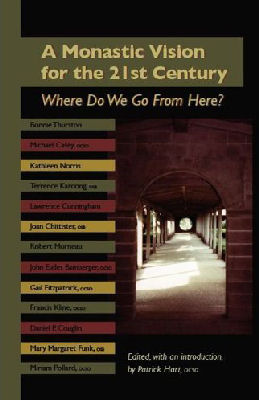
|
Posted February 14, 2007
Book: A Monastic Vision for the 21st Century: Where Do We Go From Here? Edited by Patrick Hart, ocso Cistercian Publications. Kalamazoo, Michigan. 2006. Pp. 236 An Excerpt from the Introduction:
My question was expressed this way: what can the church and world expect from monasticism in the 21st century and how do you see it ideally incarnated for the future? I asked a dozen persons to contribute to this volume which we felt would be of interest not only to monks and nuns but those legions who faithfully make retreats in our guest and retreat houses all over the world. Then, too, witness the extraordinary popularity of Taize, and more recently, Bose in northern Italy where the same kind of phenomenon unfolds before our eyes. An Excerpt from the Book: Monastic Communities Must Become Centers of Spiritual Development The days of a flourishing Catholic school system where the smallest towns in the United States of America had a Catholic church or school on all four corners of the main street are long gone. Where will the next generation gets its training in spiritual development if not in the monasteries themselves? Early monastic communities took children into their midst to train them, to educate them, to teach them the essentials of the faith. Some of those who became oblates of the community stayed there for years. Others linked themselves to the spirituality of the monastic life by public promises and lived and died faithful to the lay Benedictine life. Perhaps it is time to reinstitute those temporary live-in programs so that men and women of all ages can find in the monasteries of the country what they cannot find in their parishes: full immersion in a spiritual tradition that enables them to see life through the filters of the gospel. It may be time for us to see ourselves more as spirituality centers for the people of an area than simply degree-granting institutions. Or worse, empty remnants of an era that was once highly productive but which is now largely past. These kinds of programs have been the mainstay of Buddhism and Hinduism, Monasteries, served by a core community of perpetually professed members, provide at least a year’s training for every member of the society. This cadre then become both the mainstay of the monastery and the ongoing light of the tradition in the center of the system. They become the lay carriers of both the tradition and the spiritual life. Unless and until Christian monasticism finds some kind of similar integration of monastic values and spirit with the larger society, the light that was once the undying torch of European spirituality can only become dimmer and dimmer by the year. In fact, if we examine the flow of young people in and out of monasteries these days who come for a while and then leave, aren’t we simply doing what we fail to institutionalize and, therefore, do better? Table of Contents: Introduction “Soli Deo Placere Desiderans” Thoughts on Monasticism’s possible futures The secret ingredient Thoughts on the future of Western Monasticism Monasticism as a Schola: Some reflections from the ivory tower Old vision for a new age Monasticism: a poetic perspective Fragments for a vision of Cistercian life in the 21st century Enclosure: the heart of the matter To what holiness? Monasticism and the church today The fruits of monasticism: a view from Washington North Woods Abbey: On Lake Gogebic Epilogue: Lectio on the Easter Proclaimation |
|
